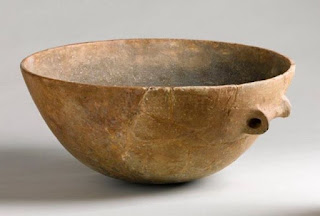 |
It wasn't until the 1960's that Peacock used petrographic, thin section analysis techniques to determine the provenance of archaeological ceramics. He determined that the Hembury bowl was made from gabbro clay from the Lizard. This threw up the question - were the potters transporting the clay or the pots from the Lizard? re-enacting a chaine operatoire can maybe enlighten this quandary. I dig out clay and don't make the pots on the site, I take it home with me to my workplace and make the pots there.
Chronology is vital here and the recent work of Alastair Whittle in Gathering Time: Dating the early Neolithic Enclosures in Southern Britain and Ireland (Whittle et al, 2011) sets out The Bayesian recalibration of older C14 dates highlighting the errors that had accrued in chronologies and pushed back the start of the Neolithic by between 1000-2000 years. The period under consideration in this dissertation is in a range of two to three hundred years.
One of the earliest dates for the period is from Broadsands chambered tomb, nr Torquay, (Sheridan et al, 2008), at 3940cal BC- and there are a few sherds of quartz tempered pottery associated with the human remains in the tomb. Hembury and Helman Tor, have the earliest C14 dates for enclosures in the region and were being constructed approximately 3700calBC. The C14 dates from Hembury were from residues on ceramic and Helman Tor from charcoal. (Whittle et al 2011). C14 dates for Raddon are based on charcoal samples and the enclosure was likely in use for only a hundred years (Whittle et al 2011).
Bibliography-I
will annotate this( this is a provisional Bibliography).
Appadurai,
A.(1986). The Social Life of Things. Commodities in perspective. Cambridge University
Press. Cambridge.
Brown, A. The Social Life of Flint at
Neolithic Hembury. 10, 1989 Page(s)46-9
Cornwall Archaeological Journals
D. Peacock No
6 40 - 44
D. Peacock No
8 47 - 65
R. Mercer No 20
1 - 205
H. Quinnel No 26
1 - 7
G. Smith No 26 13 – 67
FOSTER, G.
M.
1948
Empire's children, the people of Tzintzuntzan. Smithsonian InsL, Insl. Soc.
AnthropoL,
Pub. 6. Washington.
1948a
.Some implications of modern Mexican mold-made pottery. Southwest Jour,
Anthropoid 4:356-70. Albuquerque
,rrad, L. (2003) The Production and Trade of
Prehistoric Ceramics in Cornwall.
, Volume 1. University of Oxford, 2003 - 1120 pages
Harrad, L.(2004) Gabbroic
clay sources ijn Cornwall: A petrographic analysis of prehistoric pottery and
clay samples. Oxford Journal of Archaeology. Vol23,Issue 3. Pp271-286.
Liddell, DM. Report on the Excavations
at Hembury Fort. Third Season 1932. 1, 1929-32 Page(s)162-190
Liddell, DM. Report on the Excavations
at Hembury Fort. 4th and 5th Seasons, 1934 and 1935. 2, 1933-6 Page(s)135-175
RCHME: Industry and Enclosure in the
Neolithic: Hembury http://www.pastscape.org.uk/monumentinfo.aspx?a=0&hob_id=1181774
Accessed 22/12/12
SOCIAL LIVES OF
POTS (chair: Elaine Morris) http://www.southampton.ac.uk/innovationconference/conference/abstracts.page
Accessed online 22/12/12
Peacock, DPS 1969
neolithic Pot production Cornwall. Antiquity 43 Peacock, DPS,
1969 Neolithic pot production in Cornwall. Antiquity 43.
145-149.
Smith, I. Causewayed Enclosures.
Page(s)89-112
Thomas.
J, (1999) Understanding the Neolithic. London. Routledge.
Todd.
M. Todd, M. Excavations at Hembury
(Devon), 1980-83: a summary report. 64, 1984 Page(s)251-68
Whittle.
A, (2003). The Archaeology of people: Dimensions of Neolithic Life. London.
Routledge.
Wilson, DF. Causewayed Camps and
Interrupted Ditch Systems. 49, 1975 Page(s)178-85
Wood, I. (2011)Changing the fabric of life in
post-Roman and early medieval Cornwall : an investigation into social change
through petrographic analysis Thesis (Ph.D.) - Exeter
University, College of Humanities.
Web Sources.
Harrads Bibliography
apsimon,
a. and greenfield, e. 1972: The excavation of a Bronze Age and Iron Age
settlement at
Trevisker,
St Eval, Cornwall. Proceedings of the Prehistoric Society 38, 302–81.
carlyon,
p.m. 1982: A Romano-British site at Kilhallon, Tywardreath: excavation in 1975.
CornishArchaeology 21, 155–70.
carlyon,
p.m. 1985: Romano-British Gabbroic Pottery (Truro, Cornwall
Archaeological Unit desktopublication).
curtis,
l.f., courtney, f.m. and trudgill, s. 1976: Soils in the British Isles (London).
deer,
w.a., howie, r.a. and zussman, j. 1966: An Introduction to the Rock-Forming
Minerals (London).
edmonds,
e.a., mckeown, m.c. and williams, m. 1975: British Regional Geology:
South-West England (London, British Geological Survey).
harrad,
l.j. 2003: A ‘Sacred’ Source? Investigating the phenomenon of Cornish clays. In
Humphrey, J.(ed.), Re-searching the Iron Age (Leicester, Leicester
Archaeology Monographs No. 11), 11–16.
mercer,
r.j. 1986: The Neolithic in Cornwall. Cornish Archaeology 25, 35–80.
parker-pearson,
m. 1990: The Production and Distribution of Bronze Age pottery in South-West
Britain. Cornish Archaeology 29, 5–33.
peacock,
d.p.s. 1968: Apetrological study of certain Iron Age pottery from Western
England. Proceedingsof the Prehistoric Society 34, 414–27.
peacock,
d.p.s. 1969a: Neolithic Pottery Production in Cornwall. Antiquity 43,
145–9.
peacock,
d.p.s. 1969b: A Romano-British salt-working site at Trebarveth, St Keverne. Cornish
Archaeology
8, 47–65.
peacock,
d.p.s. 1969c: A contribution to the study of Glastonbury Ware from
South-Western Britain.Antiquaries Journal 49, 41–61.
peacock,
d.p.s. 1988: The Gabbroic Pottery of Cornwall. Antiquity 62, 302–4.
quinnell,
h. 1987: Cornish Gabbroic Pottery: the development of a hypothesis. Cornish
Archaeology 26, 7–12.
smith, g. 1987: The Lizard Project; Landscape
survey 1978–83. Cornish Archaeology 26, 13
Liddell, DM. (1930) report on Excavations of
Hembury Fort, Devon. Proceedings of Devon
Archaeological
Society 1930. 1:2, 1929, 39-63
Liddell, DM. 1931, Report on the
Excavations at Hembury Fort. Proceedings of Devon Archaeological Society 1:3.,
90-120.
Liddell, DM. 1932. Report on the Excavations at Hembury Fort.
4th and 5th Seasons, Proceedings of Devon Archaeological Society 1934 and 1935. 1:4, Page(s)135-175
Liddell, DM. 1932. Report on the Excavations at Hembury Fort
(1934and 1935), Proceedings of Devon Archaeological Society.II:3, 135-175.

No comments:
Post a Comment